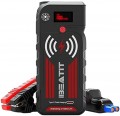Built-in battery capacity
Capacity of the own battery provided in the design of the starter-charger.
As a rule, boosters and launchers with a power bank function are equipped with their own batteries (see “Type”). The main purpose of such a battery from the point of view of helping to “light up” is to provide the power necessary to start the engine. However, in some models the battery is responsible for other functions, such as the built-in compressor or flashlight. The larger the battery capacity, the longer the device can operate, and the more tasks it can perform on a single charge.
In starting devices with the powerbank function, this parameter is also given to estimate how much energy the battery can accumulate and then transfer to connected gadgets. It is important to consider that there is a nominal (declared) and real capacity - the latter is always less, because it takes into account the inevitable losses during energy conversion. Typically the difference is from 30 to 40%, i.e. a model with a conventional battery capacity of 10,000 mAh will not fully charge a smartphone with a 3,000 mAh battery three times, but at best will provide two power cycles, because in practice its working capacity is about 6,000 mAh. Therefore, it is not entirely correct to compare the mAh values of your gadget’s battery with the nominal capacity of the built-in battery - you should definitely take into account that the real capacity is always less than the “rated” one.
USB A
Full-size USB A connectors are popular in computer technology, they are standardly used in adapter chargers for 230 V household networks and 12 V auto sockets. In starting devices, such outputs are also widely used for charging gadgets. These ports are characterized by low power, which does not exceed 15 W (although this is quite enough to charge gadgets) and a stable current strength, which is constant throughout the charging process.
USB-A (fast charge)
Full size USB A ports with fast charging support. It allows you to charge your smartphone, tablet or other connected device much faster. The charging process takes place at increased power, and the current and voltage at each stage are regulated (for example, 5V / 3A, 9V / 2A, 12V / 1.5A) so as to remain within the optimal values.
DC connector for gadgets
The presence of a
DC connector (or several such connectors) in the device to power external gadgets with direct current.
The standard DC jack is round and has a pin in the centre. And the voltages output to it can be different, the most popular options are 18 – 20 V for powering laptops and 12 V for various specialized devices. A cigarette lighter adapter can be connected to the same socket, see below for more details about it.
Power source
External power sources for which the device is designed.
—
230 V. Powered by a normal household network. Most devices with such a power supply allow connection directly to the outlet; however, if the power consumption exceeds 3.5 kW, another method of connection may be required — directly to the panel. These details should be clarified in the instructions.
—
12/230 V. Possibility of power supply both from a standard 230 V household network and from a 12-volt vehicle on-board network. This option is found mainly among boosters, while the connection to the 12 V network is usually carried out through the cigarette lighter and is used to charge the built-in battery of the device.
—
400 V. Powered by 400 V three-phase networks. Three-phase connection is not as common as 230 V, it is available mainly in workshops, large car park garages and other industrial premises. Therefore, power supply from 400 V is provided only in the most powerful "starters", for which 230 V is no longer enough. Such devices are designed mainly for heavy equipment such as buses, trucks, bulldozers, etc.
— 230/400 V. Ability to connect the device to both 230-volt and 400-volt networks. See above for details on the features of both. Here we note that such versatility is found in some high-power units that regularly use three-phase networks, however, in the absen
...ce of such a connection, they can also work from single-phase ones. Note that such a device, most likely, will not be able to connect to a regular outlet — it will need a special connection format.
— From the cigarette lighter. Connection to the car's on-board network through a standard cigarette lighter socket. In this case, it is meant to work only from the cigarette lighter, without any other options for external power supply. This option is extremely rare (more often such a connection is combined with the ability to work from 230 V, see above for details). It is used in some models of chargers designed to work in the "cigarette lighter to cigarette lighter" format. This format allows you to charge the battery directly in the car without removing it: one plug is inserted into the cigarette lighter of the car with the engine running, which plays the role of a “field power station”, the second plug is inserted into the cigarette lighter of the car, where the rechargeable battery is installed.
— From the generator. Models designed for connection to generators with unstable voltage indicators. The most popular way to use such devices is to connect directly to a car generator, hence the name. However, in addition to this, compatibility with less traditional energy sources, such as solar panels or wind turbines, may be envisaged. Anyway, with such a connection, it is necessary to constantly monitor signal fluctuations and respond to them, leaving the current parameters at the output practically unchanged; only automatic charger devices are fully capable of this (see "Type").
